Radical Retrofit
at Trinity College, Cambridge
Jonathan Taylor
 |
| Detail of the fine riverside elevation of New Court, Trinity College, completed in 1825 and now listed Grade I (Photo: Tim Soar) |
The college estates of Cambridge University include a high proportion of nationally important listed buildings by leading architects from every period since the 15th century, and the colleges have a continuing interest in showcasing the achievements of the architectural avant-garde. So, it is not surprising to find they have taken an interest in the greatest architectural challenge of the modern era – sustainability. Nevertheless, the scope of the interventions at New Court at Trinity College is astonishing. Despite being Grade I listed (the grade includes the top two per cent of all listed buildings in England), its retrofit is expected to achieve an 88 per cent reduction in carbon emissions.
New Court was designed by William Wilkins to provide accommodation for students and has been in continuous use for this purpose since its completion in 1825. The building’s construction around a central court is relatively conventional, with pitched roofs of slate with dormer windows behind parapets, solid masonry walls, and single-glazed casement windows. The façades facing onto the court are of brick, originally rendered with Roman cement incorporating fine mouldings, much of which had been repaired or replaced with a cementitious render. Others are of bare-faced brick and, facing the river Cam, ashlar limestone.
Refurbishment was required to meet fire officer requirements, to remove asbestos, to repair the fabric and to bring the existing accommodation up to a standard that would meet the needs of the college for the next 30 years. The accommodation includes 160 student rooms, some with en suite bathrooms, and a few teaching rooms and offices. Its listed status means that there was no requirement for an EPC, and that there was some flexibility under the requirements of the Building Regulations. But it was expensive to heat and its interior environment was poor. Penetrating damp meant that a high level of heating was required to keep the ground floor warm, while students on the floors above regularly had to keep their windows open to avoid over-heating.
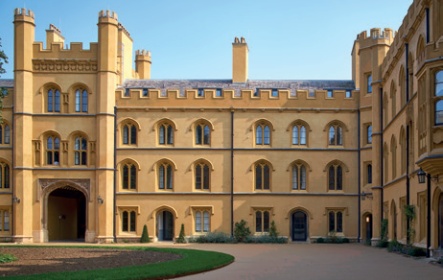 |
||
| Originally the façades facing the courtyard were all rendered with Roman cement, later repairs were executed in cement, and they have now been re-rendered using a more permeable hydraulic lime painted with limewash (above). | ||
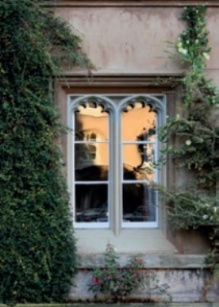 |
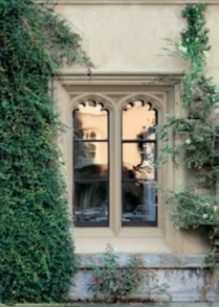 |
|
| One of the windows facing the courtyard (left) at the start of the project, and (right), the same image modified to show the architect’s proposals for re-colouring the walls and window frames, following surviving evidence of the original colour scheme (All photos: Tim Soar) | ||
Fabric repairs and improvements were therefore essential, both for students’ comfort and to reduce heating bills, but the desire to improve the thermal performance of the building went further than this, driven by an ethical interest in reducing carbon emissions.
As many buildings across the college’s estate face similar conflicts between heritage requirements and economic/ ethical requirements for conserving energy, the opportunity was taken to explore a radical approach which would challenge the flexibility of current heritage protection policy. This would provide a model for further improvements to buildings in other colleges. The sustainability measures included:
- the repair and improvement of the external envelope to conserve historic fabric and to reduce uncontrolled heat loss through damp and drafts (windows, walls, doors and ceilings)
- the addition of 60mm vapour permeable insulation to the inner face of external walls, accepting some limited thermal bridging through cross walls
- reglazing the existing windows with 10mm thin double-glazed units
- the introduction of underfloor heating beneath the original Georgian floor boards, to be warmed by ground source heat pumps at 36°C, and controlled by occupancy sensors in each room
- mechanical ventilation using the existing chimney flues for air supply and venting stale air, with heat exchangers to pre-heat the intake
- the installation of PV solar cells on south-facing roofs, accepting that they will be visible from other buildings.
PRELIMINARY INVESTIGATION AND MONITORING
A thorough understanding of the construction of the buildings and its defects was necessary in order to deal with its principal problems appropriately – damp at ground floor level and uncontrolled heat loss. Additionally, retrofitting to insulate the fabric and to control the air permeability of the external envelope has implications for moisture levels. In particular, insulating the interior faces of external walls and the underside of roof spaces leads to parts of the structure becoming cooler, potentially inviting interstitial condensation. When combined with a decrease in air movement due to draft exclusion, there is a real risk that dry exterior walls above ground floor level could become damp.
Proposals for the retrofit were therefore preceded by a three-year programme of investigation, monitoring and modelling to develop a clear picture of the hygrothermal performance of the spaces and fabric that could be most affected, and to provide a benchmark for assessing subsequent performance, from one season to another.
A modified form of WUFI software was used by building physics engineers Max Fordham to explore how the materials would be affected. WUFI (an acronym of wärme und feuchte instationär – heat and moisture transiency) tends to underestimate the thermal performance of traditional materials. Old bricks, for example, tend to be less well fired than modern ones and the clays are less uniform so they do not conduct heat as well. Nevertheless, WUFI provides a useful model for assessing the relative performance of insulation measures and the effects of cold bridging, particularly when combined with real data from monitoring the performance of the existing structures, and by material analysis.
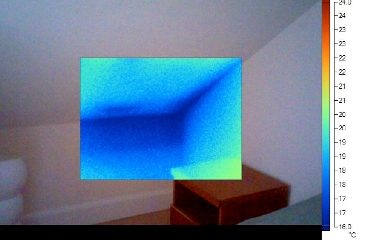 |
||
| Thermal image showing the cooling effect of condensation and poor insulation in one of the attic bedrooms: the ceilings (modern gypsum plaster on metal lath) were stripped out and replaced with insulation below and between the rafters to achieve a U-value of 0.15w/m2/°C and air-tightness of 3.0m3/h/m2@50Pa. (Image: ArchiMetrics) |
Samples of brick, stone and render were therefore sent for testing by Glasgow Caledonian University, and probes were installed by Archimetrics in 2011 to record real time variations in moisture and temperature at four depths through walls of different orientation and material. A weather station was also installed so the WUFI model could be calibrated according to the local environmental conditions and the U-values of the walls recorded by Archimetrics.
In addition to the technical impact on the performance of historic fabric, the insulation of walls and windows has a substantial design impact, and all aspects of the retrofit would affect the historic and architectural significance of the building. Before any proposals were put forward, the building was thoroughly surveyed by the architects and Beacon Planning to identify how the building had evolved, what alterations had been made in the past, and what fabric was original.
At New Court, exterior insulation was clearly out of the question. Interiors, on the other hand, were generally quite plain and had been affected by alterations over the course of 185 years of student occupation, particularly in the 1970s when extensive repairs were required for dry rot.
From a design perspective, phenolic foam insulation offers the least intrusive solution as it gives the highest insulation levels for the least thickness, but the material is impermeable. The WUFI modelling indicated that this could cause problems on those elevations most exposed to driving rain, and a permeable solution which allowed evaporation from both interior and exterior surfaces would be necessary, particularly on north- and west-facing walls.
The exception was in rooms where high levels of humidity would be expected, such as bathrooms. The solution was to locate en suite showers and bathrooms away from external walls and ventilate them thoroughly. Only two bathrooms could not easily be moved. In these cases the design of the ventilation was particularly important to ensure that the interior vapour pressure remains within acceptable levels, and moisture levels in these walls will be monitored carefully for years to come.
INTERIOR WALL INSULATION
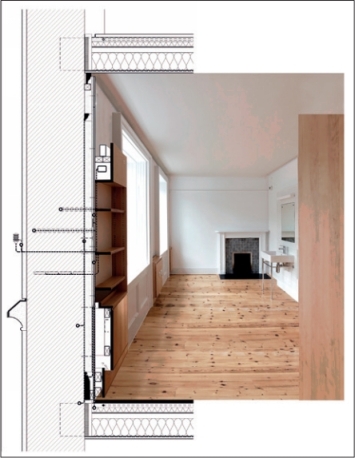 |
|
| Computer modelling indicated that the cooling effect of a 60mm-lining of vapour permeable insulation would not cause an unacceptable increase in moisture in the masonry, but long-term monitoring was essential. The diagram shows an external weather station and probes installed at different depths in the masonry to monitor changes in temperature and relative humidity. (Image: 5th Studio) |
Most rooms had been subjected to extensive repairs in the past, particularly the exterior walls, due to defective gutters and outbreaks of dry rot. Few retained original plasterwork. The exterior walls were stripped of their plaster finishes and refinished with a lime plaster base coat to ensure that all gaps were sealed, particularly where penetrated by structural timbers and joinery. As well as being essential for air-tightness, this would also help to draw moisture away from joist ends and other vulnerable timbers.
The walls were then lined using a vapour-permeable Pavatex fibreboard insulation system, 60 mm thick, and plastered to give a U-value of 0.25W/m2/°C.
WUFI and other static thermal modelling indicated that leaving the cross walls and even cornices exposed without insulation would have surprisingly little impact on heat loss, due to the relatively low thermal conductivity of the bricks. It was concluded that cold-bridging would be insufficient to allow condensation to reach a level where mould growth could occur.
Where rooms still retained original cornices, it was decided to terminate the insulation (and the replastering) just below the cornice. This would result in a rather curious detail, with the cornice running around three sides of a room as normal, before diving into a recess on the fourth side.
However, the scheme developed by the architects, 5th Studio, demonstrated that the impact of this detail on the character of the interior would be significantly reduced when combined with modern furnishings and fittings, and it was seen
as an ‘honest’ approach to the retrofit.
WINDOWS AND SHUTTERS
The original window shutters and their housing had to be removed for several reasons; first, repairs were best carried out in the workshop; second, it enabled their position to be modified so their relationship with the face of the wall, which was now insulated, could be maintained; and third, it allowed the insulation to be run behind them into the reveal. After conservation and repair, the joinery was reinstated in its new position. This created a slight gap between the shutters and the face of the windows, providing the opportunity to improve security with window locks.
Although the original windows had been replaced in the late 19th century, upgrading the glazing remains a controversial decision. In listed building terms, all alterations are considered to be part of a building’s history and the conservation authorities are rarely in favour of the replacement of single glazing with sealed units. However, many factors may be taken into consideration when assessing the significance of a later alteration, and in this case it was concluded that the replacement was acceptable in principle.
The original glass was saved for use in the repair of windows on the estate, and modern sealed units with a thickness of just 10mm were chosen from the Holloseal range. For the outer pane machine-drawn cylinder glass was used to produce an uneven reflection similar to that of early glass.
The timber casements were also draft stripped, and contacts were added to the casements to detect when they were opened, automatically turning off the heating.
ROOF INSULATION
Rooms on the top floor were partially within the roof, with no insulation in the sections of the ceilings formed against the rafters, nor in the dormer windows. All the original lath and plaster had been replaced in the past with gypsum and metal lath, so from a listed building perspective these ceilings had little significance, allowing them to be remade with rigid insulation bats between the rafters and below, retaining a generous ventilation channel between the top and the underside of the roof covering.
The roof slates had been relayed in the past over an impervious roofing felt. A vapour permeable insulation system at ceiling level would allow moisture to enter a cooler space, increasing the risk of condensation on the underside of the felt. The usual solution to this problem is to introduce additional ventilators, but this was considered too intrusive for most elevations. Increased ventilation can also increase fluctuations in humidity levels in unheated voids, by admitting warm, moist air. A modern closed-cell insulation system with vapour barrier on the warm side was therefore introduced as the most practical option. However, Historic England (then English Heritage) objected to the approach as it relies on the long-term integrity of the vapour barrier. Any defects which arise would leave timbers in the insulation layer vulnerable to condensation and decay. As many of the attic timbers are completely inaccessible, risk management relies on specialist monitoring technology.
GROUND FLOOR
In most areas the suspended timber floor had been replaced with concrete in the 1970s and walls had been replastered with a waterproof plaster. Externally, ground levels had risen and original lime based renders had been replaced with cement. As a result, there was evidence of rising damp from ground and surface water and from leaking drains, exacerbated by damp from wall surfaces and window sills above.
External ground levels were therefore reduced, drainage improved, and vapour permeability was restored to the walls and these were insulated. However, a nontraditional solution was adopted for the floor, with a conventional modern slab laid on rigid foam insulation, and isolated from the walls by perimeter insulation. This replaced both the existing slab and any surviving, but decayed timber floors.
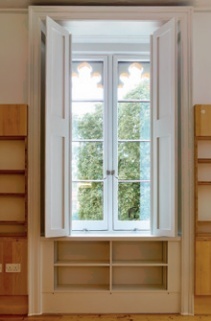 |
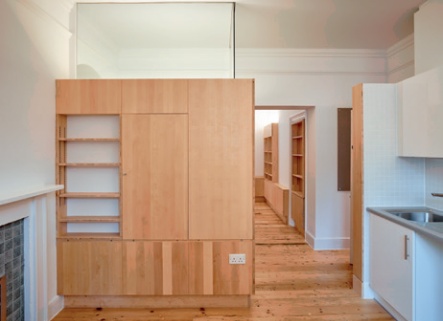 |
||
| Window shutters and architraves (left) were brought forward slightly to accommodate secondary glazing, security fixings and wall insulation. Bookcases and other fittings on either side were designed to accommodate services and (right) to hide an en suite shower. All showers were located away from exterior walls to avoid contributing to the moisture load. (All photos: Tim Soar) | |||
HEATING AND VENTILATION
The carbon footprint of the building is being further reduced by the use of renewables, with photovoltaic panels to be installed on the south facing roof slopes over Garret Hostel Lane, where they are screened from street views by adjacent college buildings, and by using heat extracted from boreholes in the central court with ground source heat pumps. Underfloor heating was therefore used throughout, including beneath the floor boards of the upper floors, with sound insulation below.
Absence detectors are used to reduce the heating level if a room is unoccupied for more than 24 hours, and window detectors will turn down the heating if the window is open for
more than 10 minutes during the colder months.
Chimney flues were used to provide controlled ventilation. Two ducts were installed, one supplying fresh air to the students’ room, and the other extracting waste air from the shower rooms and loos. In the roof a heat exchanger was incorporated into the system to extract almost 80 per cent of the heat from the exhaust, which is used to preheat the incoming fresh air supply. The system can be reversed in the summer to provide cooled air.
LEGACY – A MODEL SCHEME?
The extent of the interventions made at New Court is extraordinary for a Grade I listed building. Key changes such as the stripping of plaster from interior wall faces, the replacement of single glazing, and the replacement of the remaining timber floors at ground level with insulated concrete slabs, are all irreversible. However, the level of alteration is the product of its own unique circumstances, which include cumulative alterations to the building over many decades, the damage caused by dry rot in the past, the simplicity of its interiors, and the necessity for change to meet the requirements of health, safety, preservation and use. Perhaps above all it was the scientific approach to the issues which enabled the college to gain listed building consent for the proposals, despite objections raised by the conservation authorities. The level of change may not, as a result, provide a model for other colleges to follow, but the level of investigation and analysis certainly does.
Beneath the romantic gothic embellishments, this is a common structure of bricks and mortar. Lessons learnt from monitoring its hygrothermal performance are equally applicable to countless solid wall buildings throughout the UK, from the retrofit of Victorian terraced housing to the conversion of industrial buildings for office, residential and other uses. While the project has been based on the very best available expertise, our understanding of the long-term effects of such changes remains incomplete. That is why the decision to monitor New Court for the next seven years is so important, and it also why the legacy of this project is so valuable.



